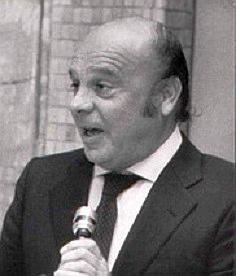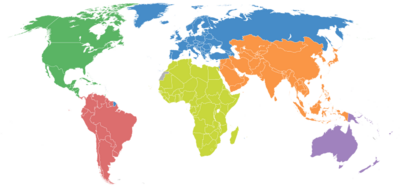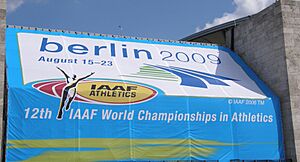World Athletics facts for kids
 |
|
| Formation | 18 July 1912 |
|---|---|
| Founded at | Stockholm, Sweden |
| Type | Sports federation |
| Headquarters | 6–8, quai Antoine-1er, Monaco |
|
Membership
|
214 member federations |
|
President
|
Sebastian Coe |
|
Revenue (2019)
|
US$55 million |
|
Formerly called
|
IAAF (to October 2019) |
World Athletics is the main group that runs the sport of athletics around the world. It used to be called the International Amateur Athletic Federation (IAAF) for a long time. This organization looks after many different types of running and jumping sports. These include track and field events, cross country running, road running, race walking, and even mountain running.
World Athletics has several important jobs. It creates the rules for all these sports and makes sure they are the same everywhere. It also checks and approves sports facilities, keeps track of world records, and organizes big competitions. One of its biggest events is the World Athletics Championships. The current president of World Athletics is Sebastian Coe from the United Kingdom. He has been leading the organization since 2015.
Contents
History of World Athletics
The idea for World Athletics started in Stockholm, Sweden, on July 18, 1912. This was right after the 1912 Summer Olympics finished there. People from 17 different countries met and decided to create a new organization. They met again in Berlin, Germany, the next year. That's when they officially formed the International Amateur Athletic Federation (IAAF). Sigfrid Edström became its first president.
The main office of World Athletics has moved a few times. It was in Stockholm until 1946, then in London until 1993. Now, its headquarters are in Monaco.
In 1926, the IAAF also helped create rules for other sports that used balls and hands, like basketball and handball. This led to the creation of separate international groups for those sports later on.
For many years, athletes were not allowed to earn money from competing. But starting in 1982, the IAAF began to change its rules. This allowed athletes to get paid for taking part in big competitions. Even so, the word "amateur" stayed in its name until 2001. Then, it changed to the International Association of Athletics Federations. In 2019, the organization decided to change its name again to World Athletics. This new name started being used after the 2019 World Championships in Athletics in Doha.
In 2020, World Athletics shared its financial reports for the first time. These reports showed that the organization earns about US$200 million over a four-year period. A big part of this money comes from the rights to broadcast the Olympic Games. The reports also showed that World Athletics had about US$45 million saved up at the end of 2018. This was helpful when the 2020 Summer Olympics were delayed because of the COVID-19 pandemic. World Athletics Day is celebrated every year on May 7.
In 2022, World Athletics took strong action against Russia and Belarus. This was because of the Russian invasion of Ukraine. All athletes and officials from Russia and Belarus were stopped from competing in World Athletics events. The Belarus Athletic Federation was also banned from hosting international events.
How World Athletics is Run

World Athletics is led by a president. The main decision-making group is called the World Athletics Council. This Council has 26 members who are chosen by voting. These members include the president, four vice-presidents, and leaders from different parts of the world. There are also two athletes on the Council.
Members of the Council are elected for four years by the World Athletics Congress. This Congress is a big meeting that happens every two years. It includes the Council members and up to three representatives from each country's athletics group. The Congress also chooses people to lead different committees. These committees focus on specific areas like cross country, race walking, and women's athletics. New committees for development, governance, and competitions were added in 2019. The rules for how World Athletics is run are written in its Constitution.
The World Athletics Council also chooses a chief executive officer (CEO). This person's job is to help the sport grow and manage its business side. Jon Ridgeon was appointed to this role in 2018.
To make sure athletes have a say, World Athletics created the Athletes' Commission. Athletes vote for other athletes to be on this commission. The head of this commission and another athlete (of the opposite sex) get to vote on the Council.
After some problems with fairness in the sport, a Code of Ethics was created in 2013. An Ethics Commission was then set up in 2014 to make sure everyone follows these rules. In 2017, a new, independent group called the Athletics Integrity Unit was formed. This unit handles all ethical issues and complaints to keep the sport fair and clean.
The International Athletics Foundation is a charity that works closely with World Athletics. It helps develop the sport through different projects. Albert II, Prince of Monaco is its Honorary President. World Athletics also has a Heritage department, started in 2018. This department collects and displays historical items from the sport. It has a gallery in Monaco and also creates online and traveling exhibitions. It also gives out plaques to mark important historical places in athletics.
Presidents of World Athletics
Since it began, World Athletics has had six presidents:
| Name | Country | Years as President |
|---|---|---|
| Sigfrid Edström | 1912–1946 | |
| Lord Burghley | 1946–1976 | |
| Adriaan Paulen | 1976–1981 | |
| Primo Nebiolo | 1981–1999 | |
| Lamine Diack | 1999–2015 | |
| Lord Coe | 2015–present |
Athletes' Commission Members

Here are some of the athletes who were elected to the Athletes' Commission in 2019:
- Renaud Lavillenie (France)
- Valerie Adams (New Zealand)
- Bernard Lagat (USA)
- Kevin Borlée (Belgium)
- Katerina Stefanidi (Greece)
- Aisha Praught-Leer (Jamaica)
Other current members include:
- Iñaki Gómez (Canada)
- Kim Collins (Saint Kitts and Nevis)
- Adam Kszczot (Poland)
- Thomas Röhler (Germany)
- Ivana Španović (Serbia)
- Benita Willis (Australia)
Chairpersons of Committees
- Athletes' Commission: Iñaki Gómez (Canada)
- Ethics Board: Michael Beloff (Great Britain)
- Cross Country Committee: Carlos Cardoso (Portugal)
- Race Walking Committee: Maurizio Damilano (Italy)
- Technical Committee: Jorge Salcedo (Portugal)
- Women's Committee: Esther Fittko (Germany)
- Athletics Integrity Unit: David Howman (New Zealand)
Area Associations
World Athletics has 214 member countries, which are grouped into 6 main areas:
- AAA – Asian Athletics Association for Asia
- CAA – Confederation of African Athletics for Africa
- CONSUDATLE – Confederación Sudamericana de Atletismo for South America
- EAA – European Athletic Association for Europe
- NACAC – North American, Central American and Caribbean Athletic Association for North America
- OAA – Oceania Athletics Association for Oceania
Partner Organizations
World Athletics also works with other sports groups, such as:
- Association of International Marathons and Distance Races (AIMS)
- International Association of Ultrarunners (IAU)
- International Paralympic Committee (IPC Athletics)
- International Trail Running Association (ITRA)
- World Masters Athletics (WMA)
- World Mountain Running Association (WMRA)
Rules and Regulations
World Athletics has rules to make sure competitions are fair and organized.
Age Categories
To make sure athletes compete against others of similar age and skill, there are different age groups:
- Senior: This is the main group for adults, with no age limit.
- Under-20: For athletes who are 18 or 19 years old during the competition year. This used to be called "junior."
- Under-18: For athletes who are 16 or 17 years old during the competition year. This used to be called "youth."
For older athletes (over 35), World Masters Athletics organizes events in five-year age groups.
Rules for Sex Categories
Most international athletics competitions are separated by sex. World Athletics has rules about who can compete in the women's category. These rules are in place to ensure fair competition for all female athletes.
For some athletes who are legally female or intersex and have certain natural body differences, specific rules apply. If these athletes have XY male chromosomes and high natural testosterone levels, World Athletics requires them to lower their testosterone to a certain level for six months before competing internationally.
In 2023, World Athletics made these rules even stricter. They decided that transgender women who have gone through male puberty cannot compete in the female category. They also lowered the testosterone limit for athletes with certain body differences and made it apply to all women's events. The president, Sebastian Coe, said these changes were made to "protect the female category in our sport."
Certified Athletic Facilities
World Athletics also approves sports venues. They give out certificates like Class 1, Class 2, and Indoor. To get certified, venues must show that their track and field areas are measured correctly.
Class 1 venues have their synthetic tracks fully tested. Class 2 venues need to show that their track surface is approved by a special manufacturer and that the facility meets strict measurement rules.
Competitions Organized by World Athletics
World Athletics organizes many big athletics competitions around the world.
World Athletics Series
These are major championships that happen regularly:
| Competition | Sport | How Often | First Held | Last Held |
|---|---|---|---|---|
| World Athletics Championships | Outdoor athletics | Every two years | 1983 | Ongoing |
| World Athletics Indoor Championships | Indoor track and field | Every two years | 1985 | Ongoing |
| World Athletics Cross Country Championships | Cross country running | Every two years | 1973 | Ongoing |
| World Athletics Road Running Championships | Half marathon, 5K run, mile run | Every two years | 1992 | Ongoing |
| World Athletics U20 Championships | Outdoor track and field | Every two years | 1986 | Ongoing |
| World Athletics Race Walking Team Championships | Racewalking | Every two years | 1961 | Ongoing |
| World Athletics Relays | Outdoor track relays | Every two years | 2014 | Ongoing |
| World Athletics Trail and Mountain Running Championships | Trail and mountain running | Every two years | 2021 | Ongoing |
Some past major events include:
- IAAF Continental Cup (last held 2018)
- IAAF World U18 Championships in Athletics (last held 2017)
- IAAF World Marathon Cup (last held 2011)
One-Day Events
World Athletics also manages many one-day competitions throughout the year. These events allow athletes to compete regularly and earn points or prizes.
Some of the current one-day event series include:
- Diamond League: The top level of outdoor track and field meetings.
- World Athletics Continental Tour: Another series of outdoor track and field events.
- World Athletics Indoor Tour: For indoor track and field competitions.
- World Athletics Label Road Races: For road running events like marathons.
- World Athletics Cross Country Tour: For cross country running events.
- World Athletics Combined Events Tour: For multi-event competitions like decathlon.
- World Athletics Race Walking Tour: For race walking events.
World Athletics started getting involved in these one-day events in the late 1970s. They created series like the IAAF Grand Prix in 1985 and the IAAF Golden League in 1998. These series helped connect different competitions and offer prizes to athletes. Over the years, the structure of these events has changed to make them more exciting and organized for athletes and fans.
Awards
At the end of each year, World Athletics hosts the World Athletics Awards. This event celebrates the achievements of athletes and others involved in the sport. Some of the awards given are:
- Male Athlete of the Year
- Female Athlete of the Year
- Male Rising Star Award (for young male athletes)
- Female Rising Star Award (for young female athletes)
- Coaching Achievement Award
- Distinguished Career Award
- Women's Award
- President's Award
- Athletics Photograph of the Year
- World Athletics Heritage Plaque: (a) Legend, and (b) Culture (started in 2023)
Russian Suspension
World Athletics was the first international sports group to suspend the Russian Athletics Federation (RusAF) in 2015. This was because of problems with doping. The suspension meant Russia could not host World Athletics events or send full teams to international championships. However, some Russian athletes were allowed to compete as "Authorised Neutral Athletes" (ANA), meaning they competed without their country's flag.
In 2022, World Athletics put more sanctions on Russia and Belarus. This was because of the Russian invasion of Ukraine. All athletes, support staff, and officials from both countries were banned from all World Athletics events for the future. The Belarus Athletic Federation was also banned from hosting any international athletics events.
Images for kids
See also
 In Spanish: World Athletics para niños
In Spanish: World Athletics para niños
- List of doping cases in athletics
- List of eligibility transfers in athletics
- World Athletics Rankings





